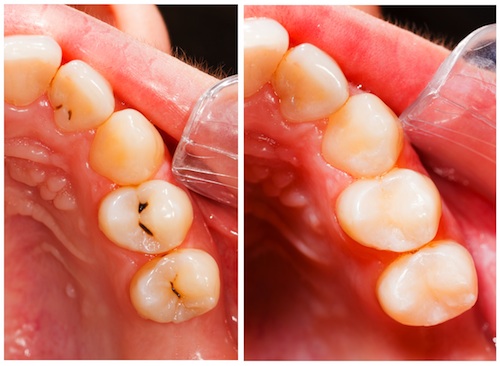Common Dental Procedures
Parents often ask us about the most common dental procedures for children’s teeth.
Whilst we advocate prevention instead of cure, sometimes kids teeth will need a dental procedure. The most common dental procedures for children, other than orthodontic braces, are extractions (removal), fillings and sealants (often called fissure sealants).
Extractions
What is tooth extraction?
Extraction is the removal of a tooth, which for permanent teeth usually results from over-crowding, decay/ disease, infection or trauma to the tooth.
How do I know if my child needs a tooth extracted?
If the tooth is affected by extensive trauma or decay/ disease that is too bad to repair, the dentist may recommend extraction. They will also discuss options such as tooth implants if the tooth needs to be replaced.
If your child’s mouth is crowded, this may impact on other teeth erupting or on the alignment of their other teeth, so your dentist may extract a tooth to give the new teeth room to come through. It may also be necessary to remove a tooth before starting orthodontics to give the teeth room to align.
How is the tooth extracted?
The extraction will depend on the severity of the situation. In most cases, your child’s dentist will numb the area where the tooth will be removed using a local anaesthetic then extract the tooth using forceps. The dentist will pack a gauze pad into the tooth socket to stop bleeding and help the blood clot, and may place a few stitches to close the gum over.
If your child is having more than one tooth removed or if the tooth is impacted, such as wisdom teeth, the oral surgeon may use a general anaesthetic. If the tooth is impacted, the dental surgeon will cut away gum and bone tissue covering the tooth, and may need to remove the tooth in pieces.
What happens after the extraction?
As the anaesthetic wears off, your child’s dentist may recommend children’s painkillers and an ice-pack to reduce swelling, and to eat soft foods.
It’s important your child continues to brush and floss, but they should avoid the extraction site. This will ensure they don’t dislodge the blood clot that forms in the tooth socket, and also minimise the risk of infection.
What if the pain continues?
It’s important to monitor your child after any medical procedure, including tooth extraction. Expect that your child may feel pain, swelling and bruising, and some residual bleeding for around 24 hours after the tooth extraction.
However if the pain or bleeding are severe after four to five hours, contact your dentist. Also, be sure to monitor your child for any signs of infection including fever, nausea or vomiting, excessive swelling or discharge from the extraction site. If there are any unusual symptoms, contact your dentist or doctor.
Fillings
What is a filling?
A filling restores a tooth that is damaged by decay back to it’s normal function and fills in the gap where bacteria enters, reducing further damage.
How do I know if my child needs a filling?
During a check-up, the dentist will examine the surface of each of your child’s teeth with a small mirror and check any potential issues more closely. They may also take an x-ray to determine the extent of any decay and damage.
What are fillings made of?
There are a number of materials used for fillings – gold, porcelain, composite resin and amalgam. Your child’s dentist will determine the best filling for their teeth, depending on the extent of damage to the tooth, the location of the filling in your child’s mouth, the cost as well as any allergies your child may have.
Gold fillings are long lasting and are made to order then cemented onto the tooth. However they can be expensive and needs several visits to mould the filling then cement into the mouth.
Porcelain fillings (also called inlays or onlays) are made to order then bonded to the tooth. They are popular as they are matched to the tooth colour, however the cost is similar to gold.
Composite resin (or plastic) fillings are mixed and placed directly into the tooth, then hardened in the mouth. Whilst they are colour-matched to the tooth, they stain easily and do not wear as well as porcelain or gold fillings.
Amalgam (silver) fillings are an alloy of silver, copper, mercury and tin. Amalgam fillings are long lasting and relatively inexpensive, however they are much darker than the teeth and are more noticeable.
How does the dentist fill my child’s teeth?
Your dentist will recommend a filling material based on your child’s situation. They will then remove the decay using a drill, laser or air abrasion instrument and clean out the affected area. The dentist may pot in a base or liner to protect the tooth’s pulp before filling with the selected material. Some types of filling require use of a special light to harden the material, and your dentist will then finish and polish the tooth.
What happens after the filling?
It may take a while for your child to get used to the feeling of the filling in their mouth, and some materials may also cause sensitivity to pressure, cold or even air. However if they continue to feel any sensitivity, pressure or pain, it’s important to contact your child’s dentist so they can determine the cause of the sensitivity and any action needed.
Fissure Sealants
What are fissure sealants?
Fissure sealants are a preventative measure, which decreases your child’s risk of decay. A layer of protective material is applied to the surface of kids teeth to prevent food and plaque getting lodged in the deep grooves of their molars and causing decay. The fissure sealant will help your child to avoid complicated procedures, discomfort and other issues in the future.
How do I know if my child needs a fissure sealant?
During a regular dental check-up, your child’s dentist will examine the surface of each of your child’s teeth with a small mirror and assess whether a fissure sealant is needed.
How does the dentist apply a fissure sealant?
A fissure sealant is applied as a liquid to the prepared tooth, and then hardened using a special light.
Is there any pain?
A fissure sealant doesn’t cause any pain when being applied or following application.
How should my child care for fissure sealants?
Regular dental care is all that’s needed for fissure sealants – brushing, flossing and regular dental check-ups to ensure the sealant remains effective in sealing out decay.





